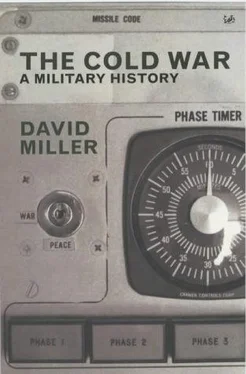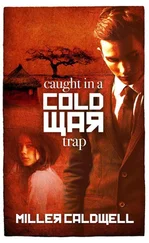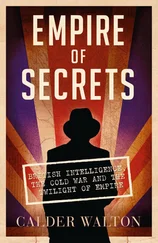As a separate issue, however, the SS-20 posed a new and serious threat to western Europe: first, its launcher was highly mobile and thus difficult to detect and destroy; second, it had three accurate MIRV warheads, which could be targeted against military targets; and, third, it increased the number of Soviet warheads from some 400-odd on SS-4s and SS-5s to 1,950 on 650 SS-20s.
To deal with this threatening situation, and in an attempt to avert an arms race in Europe, in 1979 NATO agreed on two new approaches to the problem. It decided, first:
to modernize NATO’s LRTNF [long-range tactical nuclear forces] by the deployment in Europe of US ground-launched systems comprising 108 Pershing II launchers which would replace existing US Pershing IA, and 464 Ground-Launched Cruise Missiles [GLCM], all with single warheads. All the nations currently participating in the integrated defence structure will participate in the programme; the missiles will be stationed in selected countries and certain support costs will be met through NATO’s existing common funding arrangements… Ministers agreed that as an integral part of TNF modernization, 1,000 US nuclear warheads will be withdrawn from Europe as soon as possible. Further, Ministers decided that the 572 LRTNF warheads should be accommodated within that reduced level, which necessarily implies a numerical shift of emphasis away from warheads to delivery systems of other types and shorter ranges. {4}
In parallel with this, however, in what was known as the ‘twin-track’ approach, NATO ministers also:
fully support[ed] the decision taken by the United States, following consultations within the Alliance, to negotiate arms limitations on LRTNF and to propose to the USSR to begin negotiations as soon as possible… {5}
The diplomatic track included three major offers to the USSR: a reduction in strategic-nuclear-force levels within the SALT framework, and new initiatives in both the MBFR and the CSCE processes. The military track involved fielding ground-launched cruise missiles and Pershing IIs.
The timing of the problem coincided with a general resurgence of public concern in Western countries over defence matters. This involved increased interest in some countries, but there were also small but highly vocal groups which were opposed to most forms of defence and to nuclear weapons in particular. When they found themselves faced with Soviet rejection of the ‘diplomatic’ element of the ‘twin-track’ approach, NATO members were therefore faced with a difficult choice. But, despite many predictions that they would lack the nerve, they went ahead and authorized the fielding of the new counter-systems in 1983. {6} The greatest opposition came from Denmark, where the parliament not only voted against deployment of Pershing II or GLCMs there, but also voted to withhold that element of Denmark’s contribution to NATO which would have gone towards the infrastructure costs of such missiles. In the UK there were repeated demonstrations against deployment of GLCMs in southern England, but the government brushed these aside. Helmut Schmidt, the West German chancellor, faced greater resistance from within his own Social Democratic Party than from the official opposition and threatened to resign if the parliamentary vote went against him. (He won the vote on 26 May 1981.)
Despite the opposition, US-operated GLCMs began to arrive in western Europe in November 1983, whereupon the Soviet Union withdrew from the INF Treaty negotiations in Geneva. Several weeks later it also effectively withdrew from the SALT and MBFR talks, as well.
NATO’s response to the Soviet threat posed by the SS-20 centred on the BGM-109 GLCM, a Mach 0.7 [8]missile which carried a variable-yield nuclear warhead (10–50 kT) over ranges up to 2,500 km. It flew at very low altitude, using a computer-controlled navigation system, and was extremely accurate, with a CEP of some 30 m. Four missiles were carried on a single TEL and were launched at an angle of 45 degrees. In this demonstration of NATO solidarity in the face of the SS-20 threat, no less than 116 launchers (464 missiles) were deployed to Europe, starting in November 1983 and with deployment completed in 1988. The bases were in Belgium (12 launchers), Germany (24), Italy (28), the Netherlands (12) and the UK (40).
The other element of the NATO deployment was the Pershing II missile. The Pershing IA had been deployed in West Germany since the 1960s, with 108 operated by the US army and 72 by the West German air force. [9]The Pershing IA had a maximum range of 740 km and carried a 400 kT nuclear warhead with an accuracy (CEP) of 400 m. The Pershing II used the same launcher and appeared generally similar, but was quite different internally. The main difference was in its warhead, which not only was much more accurate (with a CEP of 45 m), but had a special ‘earth penetrator’ which could drive through most types of soil to a depth of some 30 m before detonating its 250 kT nuclear weapon, thus destroying most types of command bunker. This warhead, coupled with its range of 1,500 km, posed a major threat to Soviet and Warsaw Pact buried headquarters, including those in the western military districts of the USSR.
It appeared that the Soviet authorities thought that the West would not have the nerve, solidarity or popular support necessary to achieve these deployments, because they continued with their SS-20 programme, which by late 1985 had reached a total of 441 launchers with 1,323 warheads. {7} When General Secretary Konstantin Chernenko died in March 1985, however, he was succeeded by Mikhail Gorbachev, and the atmosphere immediately began to change. Diplomatic progress became more rapid, and in December 1987 the INF Treaty was signed, under which not only would 670 Soviet missiles (including 405 SS-20s) and 400 US systems be withdrawn and destroyed, but the whole destruction programme would be subject to on-site verification by the opposite side.
The treaty laid down a three-year period for the elimination of all intermediate-range weapons and launchers (GLCM, Pershing, SS-20, SS-12 and SS-4), in two phases: deployed warheads were to be reduced to 180 on each side within twenty-nine months, with total elimination after three years; shorter-range nuclear weapons were to be totally eliminated within eighteen months. The treaty also included on-site inspections between twenty and ninety days after signature, to verify numbers, with further inspections up to the year 2000.
5
NATO’s Military Organization
FROM ITS INCEPTION NATO was involved in delicate juggling acts to balance a frequently bewildering variety of requirements. The overriding aim was to field forces which would deter an attack by the Soviet Union and Warsaw Pact, since anything else the Alliance attempted was wasted if it could not achieve that. But this had to be balanced against what was both politically acceptable and economically affordable to the members – requirements which were not always mutually compatible. Then, too, the command structure needed to share out the posts to achieve a balance between the United States, which was not only the most powerful single member but also met a very large proportion of the bills, and the remaining nations, who wished to ensure that their national aspirations were seen to be met. Finally, the organization as a whole needed to present a good public image, and to produce solutions which would not offend public opinion in any member nation too greatly.
At the top of the military organization was the Military Committee, on which all nations were represented by their chiefs-of-staff and which normally met three times a year. [1]Since the chiefs-of-staff were based in their national capitals, there was a need for some permanent representation at NATO Headquarters to conduct day-to-day business, and this was originally provided by the Standing Group, which consisted of just three members – France, the UK and the USA – with all other nations except Iceland appointing a ‘permanent national liaison officer’. The title of the group changed to the ‘Military Representatives Committee’ in 1950, and to the ‘Military Committee in Permanent Session’ in 1957. When France withdrew from the integrated military structure in 1966 this top-level body was reorganized again, being expanded to include a permanent ‘national military representative’ at three-star level (i.e. lieutenant-general or equivalent) from all nations except France and Iceland, although the title remained unchanged. [2]
Читать дальше












